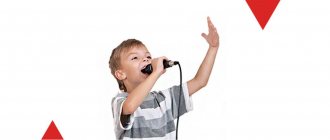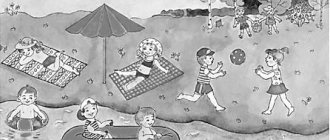Beautiful speech with movement
From childhood, most parents teach their children to follow certain rules of good manners that are directly related to speech. First of all, from a very young age it is forbidden to talk at the table with your mouth full, especially since this is quite dangerous due to the possibility of choking on food. There is also a ban on the use of various common “street” word forms in speech, which can indicate the lack of education of each person. Getting rid of talk is one of the most important tasks, according to many parents. All these rules of good manners were invented not out of a desire to limit human development, but because a well-mannered person is able to have a positive impact on society and this very society will certainly accept him. In addition to the generally accepted rules of good manners, there are also quite unambiguous ones that limit speech while moving, because talking while running cannot bring any benefit not from communication, and sports activities will be disrupted.
No person running and talking at the same time is able to concentrate either on the exercise or on the topic of conversation. Speech and movement are incompatible.
Each person talks while driving, some on a mobile phone, and some with his companion. But such communication cannot be called constructive, due to the fact that all important decisions are made not in the course of fleeting words while driving, but in the appropriate environment in offices or at the workplace.
Logorhythmics: developing speech with movement
What do children usually do in kindergarten? They move actively, sing, learn to speak correctly. Speech therapy rhythmics, or logorhythmics, is an opportunity to do all this at once, developing motor skills, speech, hearing and the ability to move in a coordinated manner. How and why logorhythmics is useful and how to practice it at home, says speech therapist Ekaterina Savina.
Ekaterina Savina, speech therapist
In the middle of the last century, biologists and doctors proved that regularly performing certain movements in a given rhythm helps with a variety of diseases and not only improves well-being, but also raises the “morale” of patients. This is how first a general - therapeutic, and then a highly specialized - speech therapy rhythm appeared. A cocktail of movements, speech and music helps children learn to speak beautifully and smoothly, and in some cases even get rid of stuttering.
What is logorhythmics
Logorhythmics is a system of exercises, tasks, games based on a combination of music, movement, words, a method of speech therapy work on the development of a child’s speech. Its goal is to solve correctional, educational and health problems.
The popularity and effectiveness of logorhythmics is due to the fact that classes are held in a playful manner based on the principle of imitation.
In essence, this is a set of physical exercises, which is accompanied by words and music. If you regularly include elements of logorhythmics in your child’s play activities, you can achieve noticeable results. Thus, this therapy helps the baby more easily navigate space and coordinate his movements in conjunction with speech and music, improves gross and fine motor skills, relieves psycho-emotional stress, teaches proper breathing, and improves phonemic hearing.
Logorhythmics classes require attention, intelligence, quick reaction, and organization from children; they help children become more relaxed and emotional. And all this improves the child’s mental processes.
Who will it be useful for?
Logorhythmics is primarily recommended for children:
- with stuttering or a hereditary predisposition to it;
- with excessively fast/slow or intermittent speech;
- with insufficiently developed motor skills and coordination of movements;
- with dysarthria, delayed speech development, impaired pronunciation of certain sounds;
- often sick and weakened;
- who are in a period of intensive speech formation (on average, the age is from 2.5 to 4 years).
Classes by age
Each period has different needs and opportunities. Logorhythmics is good because you can do it from the first days of life, however, until 2 years of age, the exercises will be passive.
From 0 to 2 and a half years
Read a rhyme or nursery rhyme to your baby while clapping your hands rhythmically. Then help your child perform the necessary movements: raise and lower his hands when he hears certain words, clap his hands to the beat of poetry or music. The same can be done with songs.
From 2.5 to 4 years
At this age, children improve motor skills, learn to speak and communicate - this is exactly what needs to be done in logarithmics lessons. If the child does not yet speak in sentences, allow him to repeat only the last words of a phrase or just the endings of words.
“Walk” (development of general motor skills)
Along a narrow path (we walk in place)
Our legs are walking (we raise our legs high)
Top - top, top - top (we stomp on each word with our feet alternately)
“Big and small drops” (development of a sense of tempo and rhythm)
Tell your child that it is raining. You can turn on the corresponding audio recording and listen to it with your eyes closed for 10-15 seconds. “How do big drops knock? That's right, they knock slowly - drip, drip, drip, drip... What about small droplets? Of course, quickly! Drip-drip-drip-drip-drip-drip..."
The child’s task is to pronounce the text by clapping his hands on his knees in given rhythms.
Finger game “House” (development of fine motor skills)
There is a house in a clearing (the fingers of both hands are widely spaced at an angle to each other, only the fingertips are touching),
Well, the path to the house is closed (the thumbs of both hands are raised up, the remaining fingers are in a horizontal position together, the tips of the middle fingers are touching),
We open the gates
We invite you to this house (palms turn parallel to each other, arms spread to the sides with palms up).
“Wind” (normalization of muscle tone, relaxation)
The wind blows in our faces
And the tree shakes (we shake with our arms raised up, tilting the body to the right and left).
The breeze is getting quieter and quieter (we slowly shake our hands).
The trees are getting higher and higher (we stretch up on our toes, our arms are raised up).
“Blizzard” (development of speech breathing)
You say, “How does the strong wind blow? Oooh... Who will portray the longest wind? The baby, after vigorously inhaling through the nose, exhales and makes the sound “U-u-u...”
From 4 to 6 years
At this age, the child’s speech ceases to be “childish” and the number of “funny” mistakes gradually disappears. Therefore, to familiar activities you need to add speech therapy gymnastics and pure speech to practice sounds.
“Turtle” (self-massage)
A turtle went for a swim (the child performs light pinching with his fingers, chest, and legs)
And she bit everyone out of fear:
Kus! Kus! Kus! Kus!
I'm not afraid of anyone!
Pure speech on the sound T (development of sound pronunciation)
Tsk-tsk-tsk - there are cucumbers in the garden (clap our hands).
Itza-itsa-itsa - a tit flew to us (we make light waves with our hands, imitating wings).
Rets-rets-rets - I pecked at the cucumber (we tap the index finger on the knees).
Tsu-tsu-tsu - I’ll give everyone a cucumber (rhythmically stretch your arms forward and then press them to your chest).
From 6 to 8 years
At this age, the child can control almost all movements, and he himself is full of energy and strength.
“Freeze” (development of reaction speed, creative abilities)
The child runs to fast music, imitating the movements of some animal. As soon as the music stops, the little one should freeze, taking a pose that conveys the image of this animal. The adult tries to guess what kind of animal the child has depicted.
Singing (breathing, voice and fluency training)
Any (even adult) song that the child likes is suitable.
“Scouts” (developing a sense of tempo and rhythm)
The adult claps a simple rhythm (for example, 2 slow and 2 fast claps) and invites the child to repeat this “secret code.” When the task begins to be completed without errors, the rhythm is no longer slammed, but played on a musical instrument. Tambourine, drum, xylophone - anything that can produce rhythmic beats is suitable.
A more complex level: the adult claps the rhythm with his hands, and the child repeats it on the instrument.
“Mirror” (development of the ability to navigate in space)
Prepare pictures with schematic images of moving men. To fast (or medium tempo) music, the child makes voluntary movements (you can run, spin, jump - the main thing is to keep in time with the music). As soon as the melody stops, the baby should take the pose of the little man drawn in the picture and freeze.
How to practice at home
Speech therapy rhythm is very simple: all tasks can be performed by a person who does not have any special training. But it's important to consider a few key points.
- The basis is imitation. The exercises are structured like this: the adult shows and the child repeats. There is no need to specifically memorize speech material: let everything happen gradually - from lesson to lesson. First, the text is read by an adult, encouraging the child to repeat. Gradually the child gets involved in reading. When he can repeat all the phrases in the right rhythm and without mistakes, the path takes the initiative.
- The result will not be soon. You only need to do logorhythmics a couple of times a week. Children who stutter - twice as often. Don’t expect a quick effect: the results will be judged in at least six months (or even a year).
- Classes should be fun. Let logorhythmics bring pleasure! During classes, you can and should use pictures, toys, bright clothes or carnival costumes, if they do not interfere with movement. In short, any items that bring joy to the baby!
- The skill needs to be honed. Repeat the exercises until they are performed perfectly. If you can’t master a task, give it up for a while, but then be sure to come back.
- Choose your music carefully. For the slow part of the lesson, waltzes (for example, from “The Nutcracker”) are suitable, for a more active part - a march, and for the “violent” part you can use the classic “Flight of the Bumblebee”. Stock up on children's songs and recordings of nature sounds.
- Focus on the child. If your child doesn’t succeed in something, simplify the task or break the lesson into several very short parts. Have you noticed that your child has difficulties with fine motor skills and sounds? Feel free to increase the number of appropriate exercises. Don’t be afraid to experiment: the main thing is to maintain the unity of music, movement and speech, but otherwise the scope of your imagination is not limited.
- Perform speech exercises carefully. Speak the poems so that the child can correlate the movements of the arms, legs, and torso with the rhythm of speech. The correct sequence is important: first, children perform the action “by demonstration”, then independently, in the right rhythm, while simultaneously pronouncing or singing the words in the same rhythm.
- Be patient. Don't be upset or angry if your baby doesn't succeed. Feeling your dissatisfaction, he may withdraw and refuse the exercise. Don’t give up what you started, even if you doubt that your child will ever cope with it.
The success of logorhythmics depends largely on whether the child likes the activities and whether he enjoys them. Listen to your baby, practice at a pace that is comfortable for him, and you will definitely see improvements.
Breath control
Yes, there are professions in which it is simply impossible to do without speech in movement, and this is primarily due to the need to inform colleagues or the public while performing certain actions related to movement. For such people, the impact of words is very important. In these cases, it is necessary to develop the respiratory functions of your body. After all, speech and movement require rhythm, and this can only be achieved with a developed respiratory system, which is able to provide oxygen to the muscles that require energy during movement, and at the same time allows you to pronounce deliberate words at the same rhythm.
Anyone can achieve a monotonous rhythm of conversation while performing a motor function, but they must be in fairly good physical shape and be able to control their breathing.
Indeed, when the rhythm of the respiratory system fails, both the rhythm of speech and the work of internal organs, which are directly related to the volume of oxygen entering the blood, are disrupted.
Indeed, almost every person notices how difficult it is to maintain the rhythm of speech when walking or running quickly, and there are people who find it difficult to speak even during a short walk.
The connection between movement and speech
The connection between movement and speech is a well-known fact that is beyond doubt. Moreover, speech, in its essence, is also a movement of the muscles of the organs of articulation and vocal cords. That is why the task of learning to coordinate speech with movement is not so difficult and comes down to developing stable skills in the coordinated work of different muscle groups.
There are many ways to achieve clear coordination of speech and movement. And the most famous and effective of them is the game. Games are the predominant method of developing the ability to coordinate speech with movement for preschoolers and children of primary school age. We all probably remember children's games in which we made specified movements and at the same time recited simple rhymes in chorus (“Bear the bear in the forest,” “Geese-geese, ha-ha-ha,” etc.). Such games, it turns out, are not only exciting fun for kids, but also help them gain basic skills in coordinating speech and movement. Games are quite often used for learning. They are liberating; with their help it is easy to explain what cannot be expressed in words. Thus, the use of games for teaching acting is widespread.
Various exercises are also used to form and automate the relevant skills. For example, jumping rope at different paces while simultaneously reciting a rhyme or tongue twister. This exercise allows you to practice speech breathing in a state of physical activity. There are exercises aimed at the ability to coordinate the tempo of speech and movement, voice strength and other speech-motor aspects.
MOVEMENT AND SPEECH - DIRECT COMMUNICATION: ADVICE OF A Speech Pathologist
Movement is one of the innate human needs. Her satisfaction is very important in childhood. This age creates the most favorable conditions for the comprehensive development of the child. During this period, called SENSITIVE, all the main aspects of the psyche are formed - thinking, memory, attention, motor skills. The intellect and its social component—speech—are also actively developing.
“Walking and movement promote brain play and thought.”
Jean-Jacques Rousseau
The brain develops along with the body. At an early age, mental development, including speech, goes in parallel with physical and sensory development. A preschooler learns about the world, masters speech, and understands the spatiotemporal connections of objects and phenomena with the help of movements. The role of mobile exercises for the formation of fine motor skills, reaction speed, coordination of movements, memory, perception, activity of the auditory and visual analyzers is invaluable.
Lack of development of gross motor skills (movements of the arms, legs, torso) manifests itself in the form of poor coordination of body parts when performing complex movements, their lack of accuracy and dexterity, and pronounced difficulties when performing physical exercises by demonstration or verbal instructions. Often it is enough to observe how children know how to dress and undress, how they fasten and unfasten buttons, tie and untie shoelaces, all this allows us to see insufficient coordination of the fingers - imperfection of fine motor skills. Deficiencies in the development of facial and articulatory motor skills are manifested in inexpressive facial expressions, difficulties or complete impossibility of pronouncing certain sounds, and general vagueness, indistinctness, and blurred speech.
IN CONDITIONS OF SELF-ISOLATION, DIFFICULTIES MAY ARISE IN CHOOSING FUN AND SUITABLE PHYSICAL ACTIVITY FOR A CHILD. WHILE AT HOME, YOU CAN, FOR EXAMPLE:
- Find sports or dance video lessons, practice and dance together, with the whole family;
- Do breathing exercises. Our speech is carried out thanks to the clear and correct work of all organs taking part in the speech act; as we have already said, an important part of speech is breathing. While performing breathing exercises, hand movements are coordinated with the chest breathing movements, correct nasal breathing is trained, and the orbicularis oris muscle is strengthened. The following exercises, performed no more than 3-5 minutes at a time, will be useful:
“Blow out the stubborn candle” - hold colored strips of paper in your right hand; place your left palm on your stomach; inhale through your mouth, inflate your stomach; then exhale for a long time, “put out the candle”;
“Steam locomotive” - walk around the room, imitating the movements of the wheels of a steam locomotive with bent arms, while pronouncing “choo-choo” and changing the speed of movement, volume and frequency of pronunciation;
“Shepherd boy” - blow your nose into a small pipe as loudly as possible to call the cows scattered in different directions; show the child that it is necessary to inhale through the nose and exhale sharply into the pipe;
“Geese are flying” - walk slowly and smoothly around the room, flapping your arms like geese; Raise your wing arms as you inhale, lower them as you exhale, saying “gu-oo-oo” (8 – 10 times);
“Hunting” - close your eyes, determine by smell what kind of object is in front of the child (orange, perfume, jam, etc.);
“Roll a pencil” - inhale through your nose and, exhaling through your mouth, roll a round pencil along the table.
Now is a great time to involve children in everyday household chores that are appropriate to their age, such as setting the table, putting away toys, tidying up the room, caring for flowers.
- Play physical activity games at home:
Lay out a straight line of newspapers on the floor. Show the path to the baby and say: “You can walk along this long path.” Show how to walk along the path using both hands to maintain balance. Ask your child to follow you along this path. If he doesn't understand, take his hands and lead him. But in this case, you will need the help of another person, whom you both will follow. If your child is good at this task, make the path more intricately shaped, with curves, or leading from room to room;
- If there are several preschoolers in the family, offer them games with a ball to develop correct sound pronunciation and speech perception:
- “We repeat the sound together” - when you hear the sound A, hit the ball on the floor;
- “The ears will hear the vowel sound - the ball flies over the top of the head” - you will hear the sound A, throw the ball up.
Of course, physical activity in the fresh air gives children more positive emotions and interest, especially in warm weather. What can you do after the period of self-isolation ends?
- Bury a treasure in the forest (a couple of colored pieces of glass), make a map with coordinates (level: “10 steps from an old snag towards the river”), age the map and take the child to search for the treasure. He will remember this adventure for the rest of his life;
- go mushroom picking together;
- walking the dog;
- jumping rope;
- play geo-hide and seek or use permanent mobile orienteering trails;
- sometimes use the stairs with your children instead of the elevator according to their capabilities;
- sing when you walk;
- fly a kite;
- Drawings on asphalt. For example, draw hopscotches for jumping or different paths that allow your child to run on them without stepping over the edges.
Motor activity and physical activity from an early age have a positive effect on speech development and mental processes. By involving the child in active games at home or on the street, parents help him systematically and timely master his native language and speech.
Text: Anna Reshetnikova, teacher-speech therapist of school No. 1811, special psychologist (MPGU)






